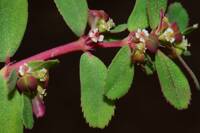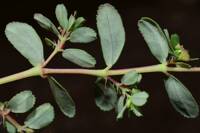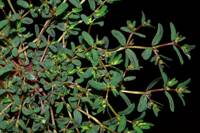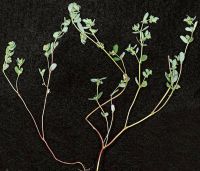Distribution: Occurring chiefly east of the Cascades crest in Washington; British Columbia to Baja California, east to the Great Plains, Great Lakes region, and eastern North America.
Habitat: Dry ground from the plains to the lower mountains.
Flowers: May-September
Origin: Native
Growth Duration: Annual
Conservation Status: Not of concern
Pollination: Bees, wasps
Monoecious, glabrous annuals with freely-branched, prostrate stems 0.5-3 dm. long.
: Leaves opposite, 5-15 mm. long, obliquely oblanceolate to oblong-ovate, serrulate near the tips; stipules lanceolate, 0.5-1.5 mm. long, usually lacerate.
Flowers tiny, monoecious, borne in axillary involucres; staminate flowers numerous, naked, each consisting of a single stamen; pistillate flower single and terminal in the involucre; involucre bearing 4 glands with sunken centers, separated by lobed, whitish appendages.
Capsules smooth, 1.5-2 mm. long; seeds 1.2 mm. long, grayish-brown, prismatic.
Publication: Syn. Pl. 2: 14. 1806.
- ssp. serpillifolia Occurring chiefly east of the Cascades crest in Washington; British Columbia to Baja California, east to the Great Plains, Great Lakes region, and eastern North America.
PNW Herbaria: Specimen records of Euphorbia serpillifolia in the Consortium of Pacific Northwest Herbaria database
WA Flora Checklist: Euphorbia serpillifolia checklist entry
OregonFlora: Euphorbia serpillifolia information
E-Flora BC: Euphorbia serpillifolia atlas page
CalPhotos: Euphorbia serpillifolia photos

































